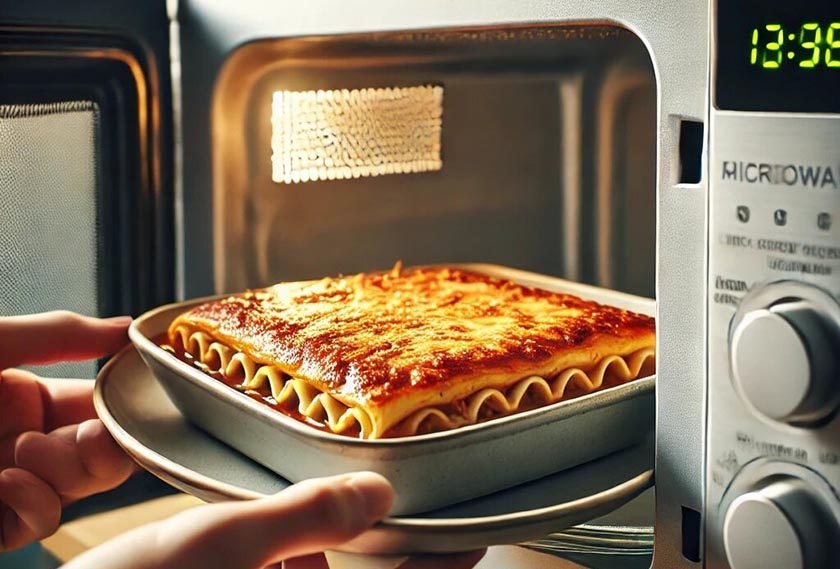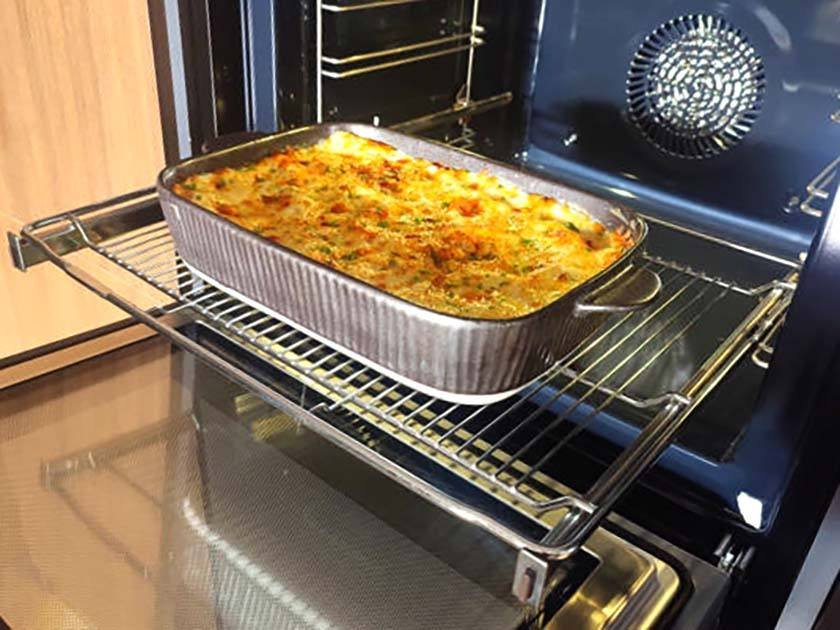Reheating lasagna can be a bit tricky – one moment it’s a delicious, cheesy dish, and the next, it’s dry and rubbery. To avoid this, the best way to reheat lasagna is essential for keeping it moist and flavorful.
Whether you have leftover meat, vegetable, or seafood lasagna, mastering the art of reheating is crucial for preserving its delicious layers of flavor.
This article will examine the best methods, highlight common pitfalls to avoid, and provide helpful tips to ensure your lasagna tastes just as good as it did when freshly made. Additionally, it will cover proper storage techniques to maintain your leftovers in optimal condition. Continue reading to become a lasagna reheating expert.
What is the Best Way to Reheat Lasagna?
Reheating lasagna can be a rewarding culinary experience when executed correctly, allowing you to preserve the authentic flavors and textures that make this Italian comfort food so beloved.
To ensure the best results, it is essential to select the appropriate cooking method – whether it be the oven, microwave, or stovetop – while also considering critical factors such as moisture retention and temperature control.
Each method has its unique aspects, and understanding how to implement effective reheating techniques will elevate your meal preparation and enjoyment.
Let’s delve into the various reheating strategies for leftover lasagna to achieve that perfect, satisfying meal.
1. Using the Oven
Using the oven is often considered one of the most effective methods to reheat lasagna, as it promotes even heating while preserving the delicious texture of the noodles, cheese, and sauce. This results in a gourmet experience reminiscent of a homemade dish.
To achieve optimal results, preheat the oven to 375°F (190°C) and bake the lasagna for approximately 25 to 30 minutes, depending on the portion size. It is advisable to cover the dish with aluminum foil during the initial reheating phase. This helps trap steam and moisture, preventing the noodles from drying out and ensuring the creamy, flavorful layers of cheese and meat remain intact.
After about 20 minutes, remove the foil to allow the top to develop a delightful golden-brown finish. Allow the dish to rest for a few minutes before serving – this is the best way to reheat lasagna as it enhances the flavors and ensures a more enjoyable meal.
2. Using the Microwave
 The microwave provides a quick and convenient method for reheating lasagna, particularly when time is limited or portion management is necessary, all while maintaining the dish’s delicious flavor.
The microwave provides a quick and convenient method for reheating lasagna, particularly when time is limited or portion management is necessary, all while maintaining the dish’s delicious flavor.
To begin, it is essential to remove the lasagna from the freezer or refrigerator and allow it to sit at room temperature for approximately 10-15 minutes before microwaving. This step promotes more even heat distribution.
It is advisable to cut the lasagna into smaller portions, as this will facilitate more uniform heating. Covering the dish with a microwave-safe lid will help trap steam, preventing the lasagna from drying out.
While reheating, rotating the plate halfway through the process will ensure all areas are evenly warmed. Confirm that the internal temperature reaches at least 165°F to guarantee food safety. Additionally, gently redistributing the sauce and cheese throughout the layers will enhance the overall flavor.
3. Using the Stovetop
Reheating lasagna on the stovetop is an effective culinary technique that allows for greater control over the warming process, ensuring that each layer of cheese, sauce, and lasagna noodles is perfectly heated, thereby maximizing flavor enhancement.
This method not only helps retain the lasagna’s original texture but also prevents it from becoming too dry. By placing the lasagna in a skillet set over low heat, you can gradually warm the dish while occasionally adding a splash of water or broth to maintain moisture. Covering the skillet with a lid will trap steam, further aiding in keeping the dish tender.
To elevate the flavor during reheating, consider sprinkling some fresh herbs or spices like basil, oregano, or even a pinch of red pepper flakes. These additions can awaken the dish’s rich flavors and create a delightful dining experience.
What Are the Common Mistakes When Reheating Lasagna?
When reheating lasagna, it is essential to be aware of several common mistakes that can compromise the quality and enjoyment of this classic comfort dish. Understanding these pitfalls – such as failing to cover the lasagna during reheating or neglecting to add moisture – can significantly affect the final taste and texture of your meal, so knowing the best way to reheat lasagna is essential to preserve its deliciousness.
By recognizing these errors, you can adopt reheating techniques that preserve the delicious flavors and culinary integrity of your leftover lasagna. Let’s examine the key aspects to avoid when reheating this cherished dish.
1. Not Covering the Lasagna
Failing to cover your lasagna during the reheating process can lead to significant moisture loss, resulting in a dry dish that lacks the rich flavor and satisfying texture characteristic of this beloved comfort food.
Covering the lasagna – whether with aluminum foil or a lid – is essential for maintaining food safety. By trapping steam and heat, it ensures that the dish heats evenly and thoroughly, thereby minimizing the risk of cold spots where harmful bacteria could flourish.
The retention of moisture not only enhances the flavor but also preserves the harmonious blend of cheeses and sauces, creating that quintessential mouthfeel. Thus, when reheating lasagna, implementing this straightforward practice can elevate your dining experience, making your meal both delectable and safe to enjoy.
2. Not Adding Moisture
Neglecting to add moisture, whether through extra sauce or a bit of water, can result in dry lasagna that fails to deliver the delicious experience expected from this hearty dish.
To restore that rich, flavorful essence, it is essential to implement a few strategic techniques during the reheating process. One of the best ways to reheat lasagna is to layer a thin spread of sauce over the top before covering the dish with foil. This simple addition not only enhances moisture retention but also revitalizes the overall taste profile.
Alternatively, you can introduce steam by placing a small pan of water in the oven alongside the lasagna. This dual approach ensures that the noodles absorb the moisture, resulting in a more appetizing and enjoyable meal.
By prioritizing these methods, you can fully appreciate the depth of flavors that make lasagna a beloved comfort food.
3. Reheating for Too Long
Reheating lasagna for too long can result in overcooked, tough layers that diminish the overall flavor and texture, ultimately compromising your dining experience.
To ensure the dish maintains its rich, luscious flavor and delightful consistency, it is essential to pay attention to the reheating method you choose. Whether utilizing an oven, microwave, or stovetop, understanding optimal reheating times can significantly improve the outcome.
For example, setting the oven to 350°F can effectively warm the lasagna in about 20-30 minutes, while the microwave may take only 5-10 minutes, depending on the portion size.
Checking frequently during the reheating process will help prevent any undesirable texture changes, allowing you to enjoy each delicious bite without sacrificing quality.
What Are Some Tips for Reheating Lasagna?
To achieve optimal results when reheating lasagna, consider implementing these practical tips. These strategies focus on enhancing flavor and retaining moisture, ensuring that every bite remains as delicious as the first.
1. Add a Little Bit of Water or Sauce
Adding a small amount of water or additional sauce to your lasagna before reheating is a straightforward yet effective method to ensure moisture retention, keeping the dish deliciously satisfying.
To implement this tip effectively, use approximately two tablespoons of water or sauce for each serving you plan to reheat. The best way to reheat lasagna is to evenly sprinkle a bit of water across the surface before covering the dish with aluminum foil, which will trap steam and prevent the lasagna from drying out.
If you prefer sauce, a light drizzle will enhance the flavor while also maintaining moisture. Preheat the oven to around 350°F and set the lasagna to reheat for about 20–30 minutes. This ensures thorough warming without compromising the integrity of the layers.
By following this approach, you not only revive the flavor but also align with other cooking tips that highlight the importance of moisture during reheating for a well-rounded culinary experience.
2. Cover the Lasagna with Foil
Covering lasagna with aluminum foil is a crucial step in maintaining its quality during the reheating process. This practice ensures that steam accumulates, retaining moisture and enhancing the flavor of the dish.
By creating a barrier that locks in the natural juices, aluminum foil not only prevents the dish from drying out but also improves food safety by minimizing the risk of bacterial growth during storage. For example, when reheating leftover lasagna, it is advisable to cover the dish with a sheet of foil. This allows the lasagna to warm evenly while preserving the creamy texture of the cheese and the richness of the sauce.
This method is particularly effective when baking lasagna for the first time, as covering it for the initial 30 minutes prevents the top from over-browning, leading to a perfectly cooked meal. Whether preparing a family feast or enjoying weekend leftovers, aluminum foil serves as an invaluable tool in the kitchen.
3. Use a Lower Temperature
Using a lower temperature when reheating lasagna enables a more gentle warming process, which reduces the risk of drying out the dish and enhances the retention of flavors and textures.
This method may extend the cooking time, which could seem counterintuitive, but it actually improves the overall quality of the meal by allowing the ingredients to meld together more harmoniously.
Various alternative reheating strategies, such as covering the dish with foil or placing a small pan of water in the oven, can complement this approach by generating steam that helps keep the dish moist and inviting.
By taking the time to reheat slowly, you can achieve a creamier consistency in the lasagna, ensuring that every bite is as delicious as when it was first prepared.
How to Tell if Lasagna is Reheated Properly?
 Determining whether your lasagna has been reheated properly involves checking for the appropriate internal temperature and assessing the texture and consistency of the layers. This ensures that you can enjoy a delicious meal.
Determining whether your lasagna has been reheated properly involves checking for the appropriate internal temperature and assessing the texture and consistency of the layers. This ensures that you can enjoy a delicious meal.
1. Internal Temperature
Using a food thermometer to check the internal temperature of reheated lasagna is essential for food safety. Ensure that it reaches at least 165°F, which confirms that it is safe to eat.
Properly monitoring the internal temperature is vital not only for preventing foodborne illnesses but also for preserving the flavor and texture of the dish. For other leftovers or meals, a quick check with a food thermometer can provide reassurance.
To obtain an accurate reading, insert the thermometer into the thickest part of the lasagna without touching the pan.
It is also advisable to minimize opening the oven frequently, as this can lower the cooking temperature and disrupt the overall heating process. Keeping the thermometer calibrated and readily available is the best way to reheat lasagna efficiently, ensuring that every meal adheres to safe consumption standards and enhancing your overall kitchen performance.
2. Texture and Consistency
Evaluating the texture and consistency of reheated lasagna is crucial – it should be soft yet slightly firm, with layers of cheese and sauce melding together to create an enjoyable eating experience.
To achieve this ideal balance, you must pay attention to the overall mouthfeel and how each component interacts. The pasta should retain a slight al dente bite to prevent it from becoming mushy, while the cheese should have a creamy texture that stretches invitingly with each bite.
A well-reheated lasagna will also possess a hint of moisture without being overly watery, as excess liquid can detract from its richness. By observing these subtle factors, you can enhance your appreciation of the dish, which ultimately reflects the culinary skill involved in its preparation.
3. Taste and Flavor
The final test for properly reheated lasagna lies in its taste and flavor – a well-reheated dish should burst with the delightful flavors of herbs, spices, and rich sauces.
To ensure a sumptuous experience, you can employ several methods during the reheating process.
Consider adding a sprinkle of freshly grated Parmesan or mozzarella atop the lasagna before placing it in the oven – this not only enhances the flavor but also creates a beautifully melted crust.
Incorporating a splash of olive oil or a dash of balsamic vinegar can brighten the taste profile, bringing out the nuances of the ingredients.
For those who appreciate a bit of heat, a pinch of red pepper flakes or freshly cracked black pepper can elevate the overall flavor, transforming leftover lasagna into a delicious, gourmet experience.
How to Store Leftover Lasagna?
Properly storing leftover lasagna is crucial for food preservation and maintaining quality. This careful approach ensures you can enjoy this comforting dish once more without compromising its flavors and textures.
1. Refrigerating Lasagna
Refrigerating lasagna within two hours of cooking is essential for food safety, as it prevents bacterial growth while preserving the quality of your leftovers.
To achieve optimal results, the best way to reheat lasagna starts with allowing it to cool slightly at room temperature before placing it in the refrigerator. Ensure your appliance is set to 40°F (4°C) or lower to inhibit the growth of harmful bacteria.
It is advisable to store the lasagna in an airtight container or to tightly wrap it in plastic wrap or aluminum foil. This will help trap moisture and maintain flavor. When properly refrigerated, cooked lasagna can last up to three to five days.
For extended storage, consider freezing portions and be sure to label each container with the date and contents to manage your leftovers effectively.
2. Freezing Lasagna
Freezing lasagna is a highly effective option for long-term food storage, enabling you to preserve its flavors and textures for future meal preparation while ensuring a convenient dining experience.
When executed properly, this method can save you time and reduce food waste, making it easier to enjoy home-cooked meals on busy days. To start this process, it is essential to allow the lasagna to cool completely before wrapping it. This step helps prevent ice crystals from forming.
Using airtight containers or heavy-duty aluminum foil will create an effective barrier against freezer burn.
Labeling the packaging with the date is also important for tracking storage time and ensuring optimal freshness. For best results, it is advisable to thaw the dish in the refrigerator overnight before baking, as this allows for even reheating and helps maintain the integrity of the flavors.
How to Reheat Different Types of Lasagna?
 Reheating various types of lasagna – be it meat, vegetable, or seafood – requires specific strategies to effectively preserve the unique flavors and textures of each variety. This approach ensures that you enjoy a delicious meal every time.
Reheating various types of lasagna – be it meat, vegetable, or seafood – requires specific strategies to effectively preserve the unique flavors and textures of each variety. This approach ensures that you enjoy a delicious meal every time.
1. Meat Lasagna
Reheating meat lasagna requires careful attention to ensure flavor retention and optimal texture, making it essential to choose the right method for a satisfying outcome.
To achieve the perfect balance of warmth and moisture, consider using the oven as your primary reheating tool. Preheat it to a moderate temperature, around 350°F, to ensure even heating throughout the lasagna. Cover the dish with aluminum foil to trap steam, which will keep the pasta layers tender while preventing the sauce from drying out.
If time is a constraint, the best way to reheat lasagna is by microwaving individual portions. Simply add a splash of water to maintain the savory flavor and prevent the edges from becoming rubbery. Regardless of the method you choose, allowing the lasagna to sit for a few minutes after reheating will enhance its overall flavor and texture.
2. Vegetable Lasagna
When reheating vegetable lasagna, it is essential to prioritize moisture retention to preserve the vibrant flavors and textures of the vegetables, thereby ensuring an enjoyable meal experience.
One effective method to achieve this is by using the oven, which allows for even heating and helps restore the lasagna’s original consistency. Preheat the oven to 375°F and cover the dish with aluminum foil to trap steam and prevent the lasagna from drying out. Adding a splash of water or broth before sealing can further enhance moisture levels.
Alternatively, you may opt for the microwave, but it is important to proceed with caution. Placing a damp paper towel over the lasagna can help maintain hydration, ensuring that each bite remains tender and flavorful.
For optimal results, monitor the reheating process closely to avoid overcooking, as this can compromise both taste and texture.
3. Seafood Lasagna
Reheating seafood lasagna requires specific culinary techniques to enhance the flavors while ensuring that the seafood retains its delicate texture and taste.
To achieve this, an effective method is to use a low and gentle heating approach, such as setting the oven to around 350 degrees Fahrenheit. This allows the lasagna to warm evenly without drying out the layers, particularly the seafood components. Covering the dish with aluminum foil can create a steamy environment that helps preserve moisture.
For an added flavor boost, consider sprinkling a dash of freshly grated Parmesan cheese or a drizzle of olive oil before reheating, which can deepen the flavor profile without overwhelming the main ingredients.
Using a microwave is also a viable option – however, it is crucial to heat in short intervals and cover the dish to avoid toughening the seafood. By incorporating these strategies, you can elevate the dining experience, ensuring that each bite remains as delightful as the original meal. Check out our FAQ section below for more details.

